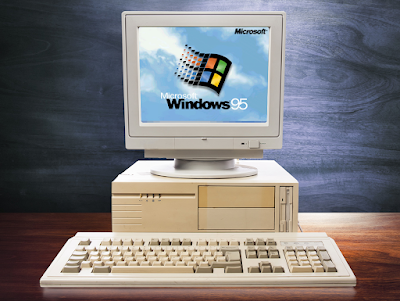I was inspired by a podcast called The 500 hosted by Los Angeles-based comedian Josh Adam Meyers. His goal, and mine, is to explore Rolling Stone Magazine's 2012 edition of The 500 Greatest Albums of All Time.
Album: #288
Album Title: Anthem Of The Sun
Artist: Grateful Dead
Genre: Acid Rock, Sound Collage
Recorded: 11 location, 5 studios and 6 live shows
Released: July, 1968
My age at release: 3
How familiar was I with it before this week: Not at all
Is it on the 2020 list? No
Song I am putting on my Spotify Playlist: New Potato Caboose
 |
| A nostalgic reminder of my 1995-era set-up |
 |
| The Windows Modem connection screen |
 |
| A typical AOL page in the 90s, News ticker circled in red |
"Is that true?" Kelly asked.
"I think so." I answered, hesitantly.
For confirmation, we tuned the television to CNN, the 24-hour news channel. After about a dozen minutes, the news ticker item was verified. That segment from the broadcast is available on YouTube here. |
| CNN broadcast from August 9, 1995 announcing Garcia's death |
Jerome John Garcia was born to Jose (Joe) and Ruth (Bobbie) Garcia, bar owners in the Excelsior neighbourhood of San Francisco. The young Garcia took an early interest in music, taking piano lessons for much of his childhood. He lost two-thirds of the middle finger on his right hand when he was four -- the result of a wood splitting accident. A year later while fly-fishing his father slipped wading into the Trinity River in Northern California and drowned.
 |
| Garcia and his dad (1947) |
The band was originally called The Warlocks, but needed to change it after learning that another group was already using that moniker. The term “grateful dead” was spotted in an encyclopedia by Garcia in the context of an Egyptian prayer. In addition to Garcia, other members of the newly minted Grateful Dead were Phil Lesh (bass, vocals), Bob Weir (rhythm guitar, vocals), Ron "Pigpen" McKernan (keyboards, harmonica, vocals) and Bill Kreutzmann (drums/percussion). It wasn’t long before their self-titled debut record was released. In 1967, an additional drummer, Mickey Hart, was recruited to the group.
.png) |
| (l-r) Kreutzmann, McKernan, Garcia, Weir, Hart, Lesh (1970) |
Subsequently, a major addition to the expanding group was Tom Constanten who played organ pieces and provided innovative and avant-garde studio techniques. He and Garcia developed a "collage" process to editing by which sections of music were spliced together to create a record that is neither a studio recording nor a live recording, but an amalgam of both. The final product is often called "Acid Rock" -- a genre meant to replicate and enhance the hypnotic and psychedelic effect of the hallucinogen LSD (lysergic acid diethylamide).
Drummer Hart has called Anthem Of The Sun the band's "springboard into weirdness" and Dead-aficionados mark it as the start of the "Classic Dead Era".
It's an enjoyable, but weird, record. Whenever I played it before or after my Grade 7 classes my students (who arrive early to drop off their backpacks) and the custodians (who popped in to empty bins and clean-up) reacted with peculiar expressions. They said nothing. I think they have all learned that “Mr. H. in Portable #16 has unusual tastes”.
I can only imagine how unique, interesting and impactful The Dead’s aural soundscapes would be to a late-sixties, LSD-activated hippy. Perhaps they, much like my friend Kelly and me, did not realize they were on the leading edge of a seismic shift in pop culture.





No comments:
Post a Comment